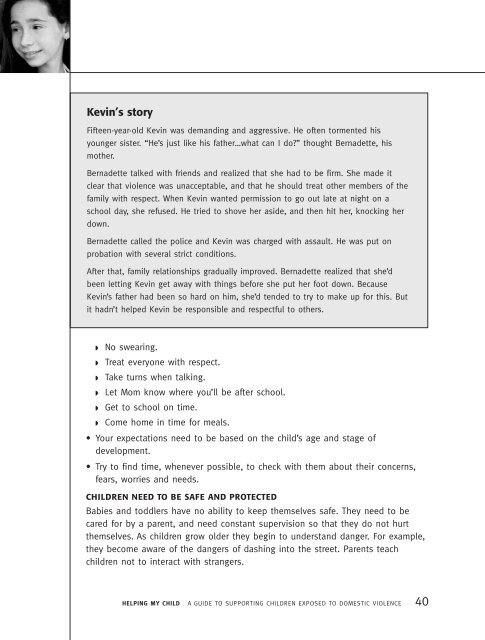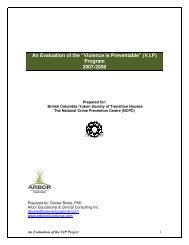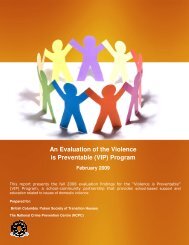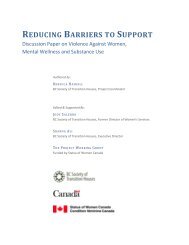a guide to supporting children exposed to domestic violence
a guide to supporting children exposed to domestic violence
a guide to supporting children exposed to domestic violence
Create successful ePaper yourself
Turn your PDF publications into a flip-book with our unique Google optimized e-Paper software.
Kevin’s s<strong>to</strong>ry<br />
Fifteen-year-old Kevin was demanding and aggressive. He often <strong>to</strong>rmented his<br />
younger sister. “He’s just like his father…what can I do” thought Bernadette, his<br />
mother.<br />
Bernadette talked with friends and realized that she had <strong>to</strong> be firm. She made it<br />
clear that <strong>violence</strong> was unacceptable, and that he should treat other members of the<br />
family with respect. When Kevin wanted permission <strong>to</strong> go out late at night on a<br />
school day, she refused. He tried <strong>to</strong> shove her aside, and then hit her, knocking her<br />
down.<br />
Bernadette called the police and Kevin was charged with assault. He was put on<br />
probation with several strict conditions.<br />
After that, family relationships gradually improved. Bernadette realized that she’d<br />
been letting Kevin get away with things before she put her foot down. Because<br />
Kevin’s father had been so hard on him, she’d tended <strong>to</strong> try <strong>to</strong> make up for this. But<br />
it hadn’t helped Kevin be responsible and respectful <strong>to</strong> others.<br />
◗<br />
◗<br />
◗<br />
◗<br />
◗<br />
◗<br />
No swearing.<br />
Treat everyone with respect.<br />
Take turns when talking.<br />
Let Mom know where you’ll be after school.<br />
Get <strong>to</strong> school on time.<br />
Come home in time for meals.<br />
• Your expectations need <strong>to</strong> be based on the child’s age and stage of<br />
development.<br />
• Try <strong>to</strong> find time, whenever possible, <strong>to</strong> check with them about their concerns,<br />
fears, worries and needs.<br />
CHILDREN NEED TO BE SAFE AND PROTECTED<br />
Babies and <strong>to</strong>ddlers have no ability <strong>to</strong> keep themselves safe. They need <strong>to</strong> be<br />
cared for by a parent, and need constant supervision so that they do not hurt<br />
themselves. As <strong>children</strong> grow older they begin <strong>to</strong> understand danger. For example,<br />
they become aware of the dangers of dashing in<strong>to</strong> the street. Parents teach<br />
<strong>children</strong> not <strong>to</strong> interact with strangers.<br />
HELPING MY CHILD A GUIDE TO SUPPORTING CHILDREN EXPOSED TO DOMESTIC VIOLENCE 40






